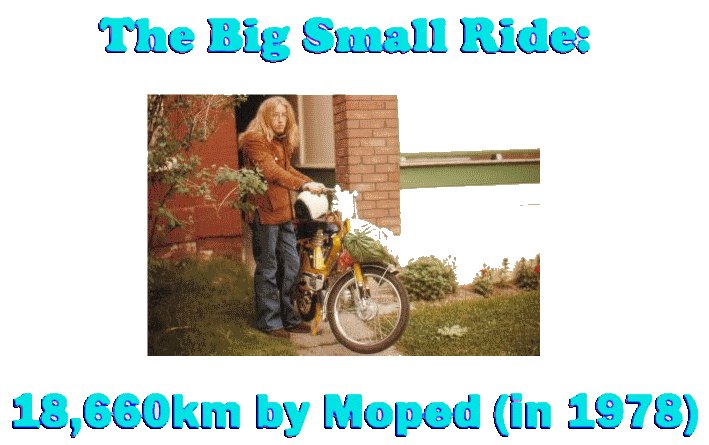
(Pictures used with permission from Walter Muma, Question and Answer sections are from a phone interview with Walter Muma in November, 2020 and have been edited for length)
Quite some years ago, I started out my two wheeled riding career on a 1970’s Puch Maxi moped.
It was a bright sporty orange colour, which told cheerful lies about power and speed. It was used for putting around the urban streets of Toronto in a cloud of blue tinted two stroke smoke. It spent most of its’ days parked in bicycle racks while running into work and on errands. It was my first taste of freedom from the perils of walking and public transit – my first flimsy voyages into exploring more than bus routes and streetcar tracks.
I didn’t see myself leaving the city with it however, it didn’t even really occur to me. I was a city kid born and bred and the vague spaces past Steeles were the stuff of legend and mystery – I had a whole city to explore, and I didn’t set my gaze much past the borders of the downtown.
That is, until I stumbled – in those earlier days of the internet – upon a website that had the story of a moped trip.
From Toronto into northern Ontario, west across the prairies, into the Yukon and Alaska, and back. On side highways, across dirt and gravel roads – taking place in 1978.

Likely the longest moped trip in the world well into the 2000’s (if you count mopeds as 49cc machines with pedals, instead of lumping together any small motorcycle or scooter into that classification.)
It was a trip taken by Walter Muma, and reading about that trip changed everything.
“Was there any special reason you chose the Mobylette Moped?”
.
“Because around the corner from where I lived there was a Mobylette dealer. It wasn’t a conscious choice, I didn’t shop around – I thought ‘Cool let’s get a moped’.
It turned out to be a good choice, because the Mobylettes were heavier and more solidly built. So they tend to ride a bit more like a motorcycle than a motorized bicycle.”
After reading it, I was inspired to start taking my little machine out to the edges of the city. Then beyond. I did camping off of a 125cc scooter – and eventually I even retraced much of Walter’s trip on a Russian sidecar bike, and had my own adventures and saw just how big Canada really is – the only way you can truly appreciate it. On a slow, two (or three in this case) vehicle, out in the open.
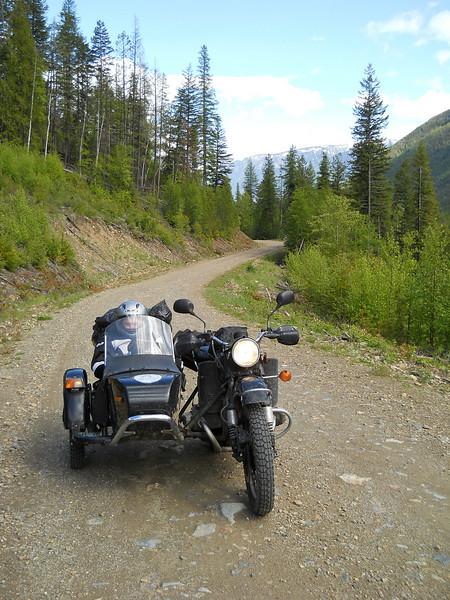
In the weather, the trees, the mountains, and the impossible spaces of the prairies. Through the rush of waterfalls, to both edges of the continents – all of these things I’ve seen and all because of this one story I found and read about a moped, a man, and one amazing trip.
And now, we’ve had the chance to interview him – and to tell this story yet again. Maybe finding some new audiences to tell it to.
So lets get to telling it.
“You mentioned that you actually had a car at the time but decided to take the moped? And was that because of your experience hitchhiking and bicycle touring – you wanted that experience of being out in the open?”
“Yep that’s right, and moving slowly. Also, a moped attracts a lot of attention – at least back then – when you are using it to travel, so I found it rather ironic that anytime you stopped for lunch and sit on a guardrail and eat a sandwich of something – all kinds of people stopped to ask if I needed help.
But ironically, the two times where I did (need help) when I wiped out on the Alaska highway once and once up near Dawson city, Yukon – my jeans were ripped and, you know, I wasn’t severely hurt or anything but scratched up and it’s sitting by the side of the road contemplating that and nobody stops.”
1978, June 3rd, Walter Muma left Toronto for a trip that would take him almost a hundred days and end up covering 11,500 miles or 18,660km’s – going from Toronto north and west all the way across the country to the Yukon and Alaska, ending up travelling the Dempster Highway to Inuvik, NWT before returning to Toronto.
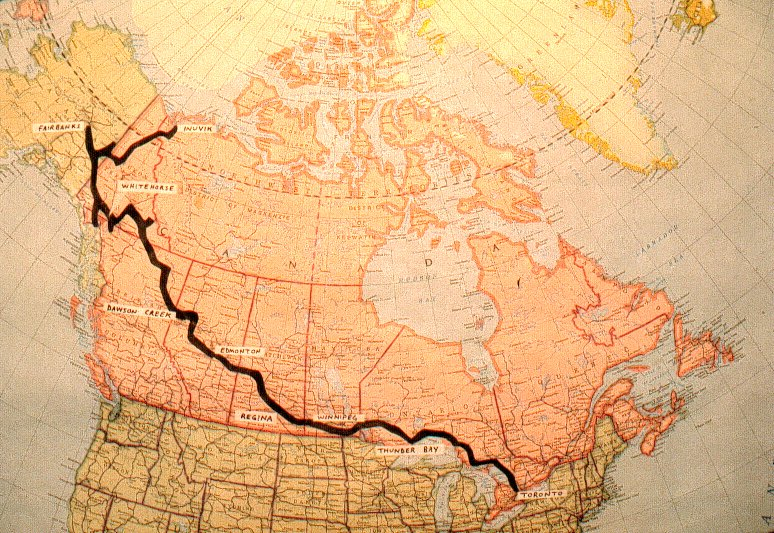
He did this (despite owning a perfectly functional car) on a Mobylette moped bought new for the trip. This is a machine that you would expect to see on the streets of Paris, something anyone would normally describe as city transportation or something you’d run errands on – not something you’d expect to take on a trip that many people would spend serious time preparing touring motorcycles for.
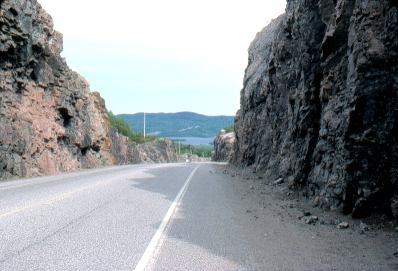
Not that Walter didn’t spend a great deal of time preparing mind you – he had another identical Mobylette he had taken on a tour across Ontario and the eastern provinces (putting about 21,000 miles on it before taking it apart for spare parts for the trip.)
“Out of curiosity, because all your pictures show you wearing jeans and fringe jacket – was that what you were wearing for most of the trip? Did you find the weather a challenge in that riding gear”
“No, not really. I’ve been up to up to Alaska and I was 17 I got caught in a snowstorm in August. So I was aware the weather could change.
When I was heading back down from Alaska down the Alaska Highway back from out west it got pretty chilly actually. I found some discarded reflective foil and I put inside my jacket to help keep warm and I could only ride for about an hour before I got too chilled and had to stop and make a fire to warm up. So
sometimes the weather wasn’t great – you know, in the latter part of the summer. Heading up north in June, there was heavy frost and icicles one morning I remember on Lake Superior.
But mostly the weather was pretty comfortable. no issues with that.”
His moped adventures actually started in 1975 – a seemingly natural progression from several extended bicycle tours he had taken – and the three summers he spent travelling and camping with the old moped were what had prepared him for his trip in 1978, giving him the knowledge on how to repair the moped, knowledge of how the machine operated and what was likely to need replacing or maintenance, and tools and things he would need to bring.
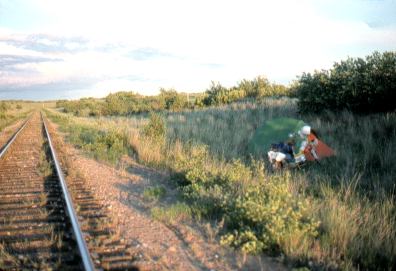
His old machine was stripped and sorted into labelled parts, ready to be shipped if needed. It was arranged with friends to buy and ship parts if needed – since a Mobylette dealer was unlikely to be found in the small towns and this was, of course, pre-internet days when ordering something online for quick delivery…. wasn’t on option.
Self-sufficiency was essential. And it had to be fitted into packages that could be carried on a very small – very French motorized bicycle.
“About the terrain. you mentioned some of the challenges like the day it was raining on the clay road that
clogged your tires to the point where they wouldn’t turn for example?”
“Yeah, there’s a stretch up on the Alaska Highway where it is almost entirely unpaved. It’s since been completely rebuilt. But there was a section under construction and it was clay and there’s these giant Earth hauler things barreling up and down the highway and every now and then they go around and here’s me just walking my moped along the same stretch of road under construction – that was a little bit hairy.”
And then yeah, there was one place I got stuck in the Yukon or northern BC for three, four days and ran out of food. People stopped at the picnic area or campground or whatever it was and were very kind and generous inviting me for meals. So it’s kind of nice.”
Speaking of the Moped – and we should, since in some ways it just as as important a character in this story – we should talk about the history of the Mobylette.
The Mobylette is a moped made by the French company Motobecane, and it was first introduced in 1949.
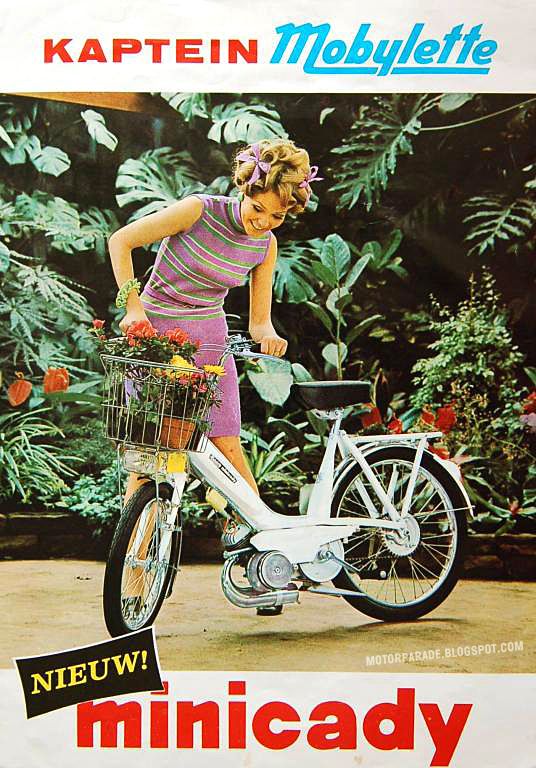
Over an almost 50 year period, over 30 million of these machines were manufactured – becoming iconic to the point in which they were featured in a set of stamps, and feature in several notable French films such as Amelie – in which the male lead searches through Paris for the titular female character on his Mobylette.
Which perhaps makes it all the more remarkable to find one not, as you would expect, hurtling across Paris – but instead heading West, North and up into the wilds of Alaska.
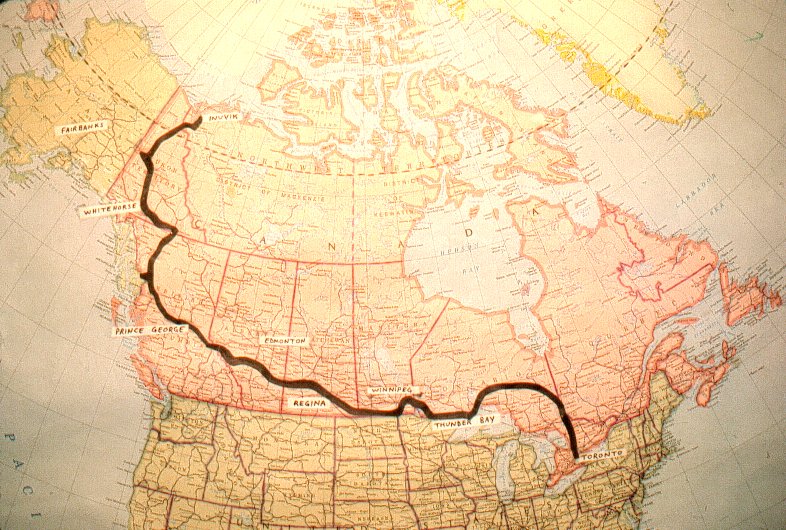
We mentioned Walter started this trip on June 3rd, 1978. June 6th he was on Highway 129 (known at that time as the “Chapleau Route” of the Trans-Canada Highway.) This was an isolated stretch, passing through no towns at all over a couple of hundred miles.
By June 12th, he crossed the Manitoba border. Mopeds (at the time) were not really allowed in Manitoba, so he had to divert to the side roads to avoid attention – having some difficulty with soft sand and other unpaved road surfaces. He reached Saskatchewan on June 14th, taking a side trip to Moose “Mountain” – which isn’t much of a mountain, but when you are a hill-challenged province you take what you can get.
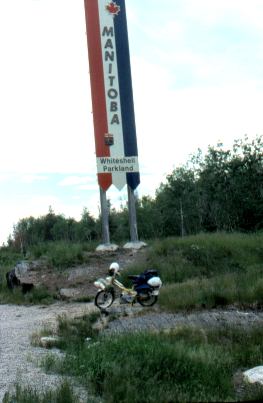
By June 18th he reached Alberta, BC on June 24th, from here he toured around the Yukon for a while – eventually riding on every mile of the Alaska Highway. The Alaska Highway starts near Dawson Creek, in mid-northern BC. The first 144 km’s were paved, but after that you had 1600kms of gravel road (with just a few paved sections) all the way up to the Alaska border. (This has changed since, with the entire highway now being paved.)

For a street going moped, heavily laden with gear and supplies – 1600km of mostly gravel road had to be a challenge at times. Though once he reached Alaska, it became paved again.
“When it comes to human interactions- did you have a lot, or was it more time spent riding alone? Were you constantly meeting people, and how were those?
“Yes to both. So yes, a lot of time writing alone, but anytime it stopped, people would want to come over and want to talk to me because it was unusual.
The whole West – at least back then – there are these countless little campgrounds like picnic areas in Ontario, but they’re a campground. They’re free. People just stay at them. So you’d get, you know, like maybe five, six people at the most. And at night you’d talk to each other and stuff. So lots of interactions and lots of alone time. So both yeah.”
Walter travelled up the highway to Watson lake, then beginning his explorations of the Yukon and also Alaska – heading up the Robert Campbell Hwy and the Nahanni Range Road, as well as the Atlin area and eventually continuing up the Alaska Highway to Fairbanks, Alaska. (EDITOR’s NOTE: We highly recommend reading his account at http://mopedtrip.com for a more detailed description of his ride.)
Along the Alaska Highway he ran into one hazard most mopeds will never see – wet clay. The highway department would heavily water the road to keep the dust down, but this made travel by two wheels almost impossible, as at the time much of the Alaska Highway was made of clay based layers and it would get very sticky and clog the wheels of the moped when wet – completely stoping them from turning.
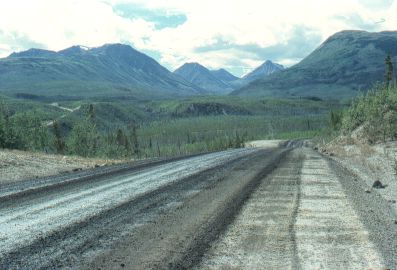
This required stops to remove the claw from the wheels and mudguard, and the lack of traction didn’t make an easy ride even when the wheels didn’t immediately clog. This road surface eventually became even more of an issue when it rained for two days straight – causing Walter to run out of food. Fortunately some tourists stopped by the campground in which he was sheltering and shared their food.
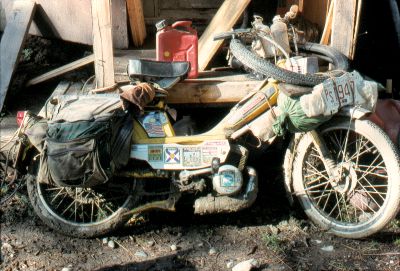
“So a good balance of both solitude and company along the way?”
“Yeah, a very good balance. Very good balance. I met a lot of people. The only time any negative stuff happened was up in northern Alberta. I was camped somewhere and there were some guys working on the oil patch. I guess young guys. They walked past my tent at night and they jiggled my tent as they walked by. And they said, ‘Be careful, might be a great big guy in there riding that tiny moped’ you know – making fun. But, you know, they’re just jerks. Like they tend to be sometimes”
Shortly after this, Walter reached the Dempster highway. The final section of road had just been completed, and it wouldn’t actually be officially open to civilian traffic until 1979.
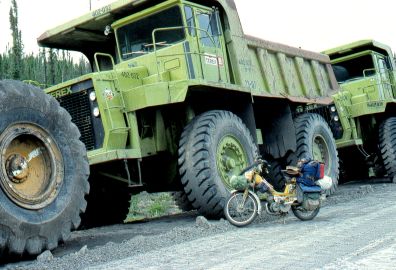
This little moped – which should have been out fetching groceries or going to the coffee shop – was one of the very first civilian vehicles to travel parts of the highway. Maybe the very first civilian two wheeled to go on those stretches at all.
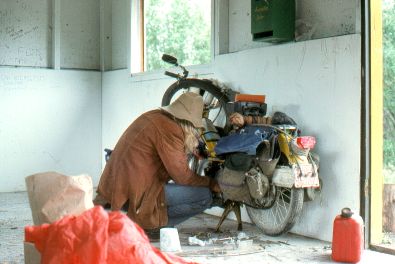
He was definitely the first person to travel on it on a moped – and the only one for decades to follow I’m quite sure.
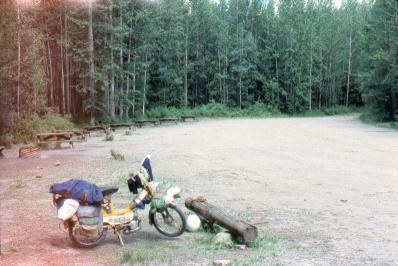
“How did you navigate -carrying all the maps that you would normally think you would need on a trip this long – when you are on a moped that’s packed to the gills?”
“I had one map per province – and they were easily obtained.
I probably didn’t even have maps for the whole trip. I got them as I went along. So it’s not many maps, maybe five or six, no big deal. I never had any problem with getting lost along the way even when I would divert to the side roads. I’ve never been lost in all the travelling I’ve done and all the wilderness backpacking, canoeing etc – I’ve never really been lost. Not in the sense of truly not knowing where I was or how to get out of there.
I’ve always seemed to have a knack for knowing where I am.”
From here he would travel up into the Arctic circle, north to Inuvik – before travelling south, and starting the very long ride home.
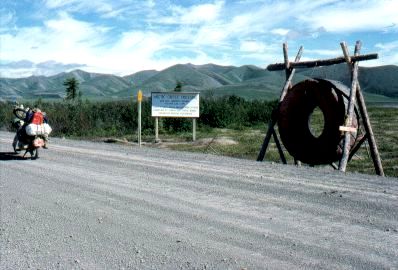
Again, I am sure the first on a moped for many of these roads – and there are probably still more than a few where his moped is the only pedal-equipped motorized bicycle to have travelled them to this day.
“You mentioned you took the back roads in Manitoba to avoid attention since mopeds were not technically allowed. Did you have any negative attention from authorities during the trip?”
“Not really, no. Once a cop pulled me over somewhere in the prairies. I was thinking “Oh, geez. What does he want?” and it turns out, he’s just interested in talking to me. Because it was riding a moped – he just wanted to talk to me as a person.
But no, no negative attention whatsoever from law enforcement or anything like that. And crossing the border was no problem – going into Alaska wasn’t bad anyways.”
In 2002, Walter’s trip was submitted to the Guiness Book of World records for the longest moped trip in the world. It was however rejected as Guinness did not differentiate between things like the Honda Cub (which has no pedals) and the Mobylette – which is a true moped.
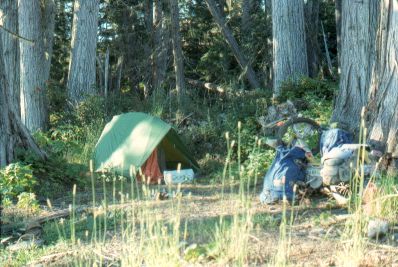
As well the term “Moped” is used in some places to mean any 50cc scooter or motorcycle – so admittedly, finding a legal or definitive definition of “moped” that would fit all places, all countries – isn’t going to happen.
However, I think Walter’s trip deserves at least our unofficial recognition for just what an accomplishment it was. A little tiny, pedal start machine – going where no other machine of its’ type had ever been.
Indeed, Walter’s record on a moped was only broken in 2006, when Denieulle Benoit rode 27,270km throughout Europe until his moped was stolen in Prague.
We should probably take note, if you are going to go tens of thousands of kilometres on a moped, you should do it where the only things around are wildlife who are unlike to steal your machine.
Denieulle Benoit broke even this record in 2009, when he travelled 33,068km through the USA and Canada in 226 days – covering at least some of the same areas as Walter. Should you wish to read up on on this trip, you can find his website at http://www.deniol.com/.
(EDITOR’S NOTE: Denielle’s trip was also done on a Mobylette moped… perhaps the Long Way Round riders chose the incorrect machines? Maybe adventure riders need to rethink what they ride? This may possibly not be a universally accepted theory however.)
“Your costs were quite low for the trip – you mentioned roughly around $300 – a little over $300 for the trip. What were some of the ways that you kept the costs down?”
“So while riding the moped, I got 200 miles per gallon. I never stayed in a motel, not even one and never paid for a campground- but always found somewhere to camp that was either free or an informal place somewhere off the road.
Never had to pay for places to stay. And then people would invite me to stay in places as well.
So zero accommodation costs, never eaten a restaurant not even once. Always a grocery store food. Or sometimes people share things, of course.
So that’s another way. So those are the main things accommodation, and food.”
But while Denieulle’s trip was impressive – I still think Walter’s trip was more of an accomplishment.
We have mentioned this entire trip was done in a fringed suede jacket and jeans didn’t we?
Though he did have a rain suit for the bad days.
No modern breathable protective motorcycle gear.
No full face helmet. Exposed to the elements day in and day out. Riding on occasion with frost in the morning and riding through the wet.
No GPS, no cellphone, no internet to plan things. No overnight delivery from amazon – you had to be your own rescue party if things went wrong.
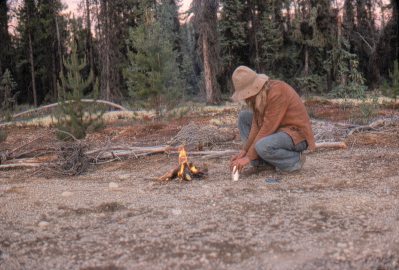
“Was there any especially memorable places that you stayed at? Or any off the road camping spots?”
“There probably were but on the side of a lake or something like that, you know? Yeah. It’s hard to do. And when you’re doing a trip of that scale, it’s hard to I guess, pick out individual moments. Yeah, it was like 100 and 100 plus nights. So I don’t remember any campgrounds per se that were memorable.
I remember meeting people and that kind of stuff. And, you know, most of that is documented pictures on my website. Like the picture where there’s a lot of motorcycles going up the Alaska Highway because of the challenge of riding basically a thousand miles of gravel road. And at one campground there was like four or five motorcycles there. And so we lined up all our bikes with my relatively tiny moped beside their machines – the picture is kind of cool.”
During the interview with Walter one thing that kept coming up with the notion of self-sufficiency, and the importance of simplicity in travel – which was one of the major reasons he chose the moped as his vehicle.
This is something I think any of us would do well to remember – especially in these days of complexity – of electronics and the changing nature of international travel. There are still ways you can have an incredible experience, discover the vastness of the world, and truly experience what the natural world has to offer.

And you don’t have to spend a huge amount to do it – you need need to practice, prepare, and try.
“Kind of ironic in a way – because they’re sitting there thinking they made it all this way on up into Alaska on their motorcycles. Then you come riding in on the moped.”
“Yeah, they were pretty astonished.
They really admired it. I got that universal reaction from motorcycles. A “Wow, amazing type” kind of thing. You know, I even met a guy on a bike and he had put two extra wheels on his back tire like training wheels on his motorcycle. Because of the thousand miles of gravel road. The Alaska Highway had quite a reputation.
People put screens across their windshields have them installed across the windshield and the whole bit. Yeah, it was it was quite a trip usually asked people for days to drive up to Whitehorse, which is mile 923. I think it was. So it was it was definitely a challenge and adventure.”
That’s why this trip changed my life. It has led to a sidecar trip in Europe in which we threw away the plan and just explored.
It has led to coast to coast trips on machines that some would say aren’t appropriate for long trips.
It’s led to me being on a mountain pass, miles from anyone else. It’s led to being stopped on the side of a highway in the prairies – stunned by the expanse of grass and the sky.
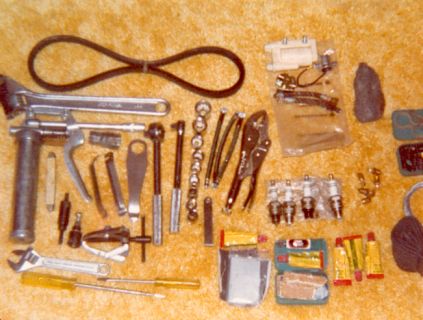
It’s led to amazement, trouble, and the occasional unpredictable moment and story that still goes unbelieved when I tell them to others.
And I owe that all to Walter.
At one point one of Walter’s friends sent him a link to his Wikipedia page and told him “Now, you’re immortal.”
I’d say they were more right than they knew.
LINKS:
Walter’s webpage, detailing the trip and what was involved in terms of time and logistics (with some great photos as well – we highly recommend reading his account):
http://www.mopedtrip.com/
Wikipedia page for Walter’s trip:
https://en.wikipedia.org/wiki/Walter_Muma
Denieulle Benoit‘s 2009 Moped trip which (likely) was the first to beat Walter Muma’s 1978 trip for distance travelled on a true moped.
http://www.deniol.com/
Wikipedia Mobylette entry – for the history of this little moped that could.
https://en.wikipedia.org/wiki/Mobylette

Great to hear more on this adventure!
As someone who owns and currently rides a Moby 50v around Toronto, it’s incredible to imagine riding it to Alaska, wow!
I wish there were more who still owned and enjoyed these incredible machines.